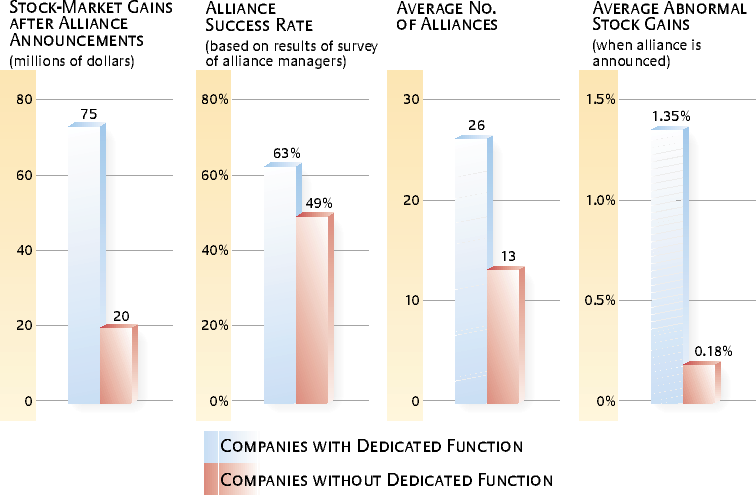How To Make Strategic Alliances Work
Topics
Strategic alliances — a fast and flexible way to access complementary resources and skills that reside in other companies — have become an important tool for achieving sustainable competitive advantage. Indeed, the past decade has witnessed an extraordinary increase in alliances.1 Currently, the top 500 global businesses have an average of 60 major strategic alliances each.
Yet alliances are fraught with risks, and almost half fail. Hence the ability to form and manage them more effectively than competitors can become an important source of competitive advantage. We conducted an in-depth study of 200 corporations and their 1,572 alliances. We found that a company’s stock price jumped roughly 1% with each announcement of a new alliance, which translated into an increase in market value of $54 million per alliance.2 And although all companies seemed to create some value through alliances, certain companies — for example, Hewlett-Packard, Oracle, Eli Lilly & Co. and Parke-Davis (a division of Pfizer Inc.) — showed themselves capable of systematically generating more alliance value than others. (See “A Dedicated Function Improves the Success of Strategic Alliances, 1993–1997.”)
How do they do it? By building a dedicated strategic-alliance function. The companies and others like them appoint a vice president or director of strategic alliances with his or her own staff and resources. The dedicated function coordinates all alliance-related activity within the organization and is charged with institutionalizing processes and systems to teach, share and leverage prior alliance-management experience and know-how throughout the company. And it is effective. Enterprises with a dedicated function achieved a 25% higher long-term success rate with their alliances than those without such a function —and generated almost four times the market wealth whenever they announced the formation of a new alliance. (See “Research Design and Methodology.”)
References
1. B. Anand and T. Khanna, “Do Companies Learn To Create Value?” Strategic Management Journal 21 (March 2000): 295–316.
2. P. Kale, J. Dyer and H. Singh, “Alliance Capability, Stock Market Response and Long-Term Alliance Success,” Academy of Management Proceedings (August 2000).
3. J. Bleeke and D. Ernst, “Collaborating To Compete” (New York: John Wiley & Sons, 1993); and “The Way To Win in Cross-Border Alliances,” The Alliance Analyst, March 15, 1998, 1–4.
4.“Dispelling the Myths of Alliances,” Outlook (1999): 28.
ADDITIONAL RESOURCES
A helpful resource is John Harbison and Peter Pekar’s “Smart Alliances: A Practical Guide to Repeatable Success,” published in 2000. For a more scholarly development of ideas in the article, we recommend: Y. Doz and G. Hamel’s 1998 book from Harvard Business School Press, “The Alliance Advantage: The Art of Creating Value Through Partnering”; J. Dyer and H. Singh’s 1998 “The Relational View” in Academy of Management Review; R. Gulati’s “Alliances and Networks,” which appeared in Strategic Management Journal in 1998; “Building Alliance Capability: A Knowledge-Based Approach” from the 1999 Academy of Management Best Paper Proceedings and “Alliance Capability, Stock Market Response and Long-Term Alliance Success” from the 2000 Academy of Management Proceedings, both by P. Kale and H. Singh. Also of interest are J. Koh and N. Venkatraman’s “Joint Venture Formations and Stock Market Reactions,” which appeared in 1991 in Academy of Management Journal; M. Lyles’ “Learning Among Joint-Venture Sophisticated Companies” in a 1998 Management International Review special issue, and Bernard Simonin’s 1997 article, “The Importance of Collaborative Know-How” in Academy of Management Journal.


